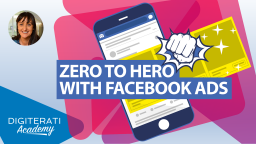Facebook’s Power Editor ads platform is certainly not for the faint hearted, but once you’re confident with it, it’s unlikely you’ll return to the native “self serve” ad platform.
[Note: Facebook now longer uses Power Editor. Instead the new Ads Manager platform combines all the features of Power Editor and more]
I’ve used it for several years now, and went through the pain barrier because back in the day it was the only way to surface really good sized newsfeed ads (using the now virtually defunct “dark post” function). As with many things Power Editor, this and other features has been rolled out onto the self serve platform, but there are still good reasons to be using Power Editor.
Here’s a compilation of reasons to use Power Editor. As with all things Facebook, functionality changes on a near daily basis so please do correct me if I’ve missed something:
16 reasons to use Power Editor when creating Facebook ads
- New features are rolled out on Power Editor first
Most features do eventually get rolled out onto the self serve platform but you’ll get better engagement and click through rates while they are novel. I was able to surface really large size images in newsfeed ads a long time before the competition because they were first available as “dark” posts via Power Editor. - Save and reuse audiences – a huge time saver
Rather than having to laboriously re-create your targeting for each ad, Power Editor lets you save target audiences. - You can place ads by mobile device and choose not to show ads on mobile devices not connected to wifi
This is a particular benefit if you are concerned that your audience will not click through while not on wifi. A particular problem for American audiences where the price of data is very high. Also useful for video ads where users may not want to view from within their mobile data allowances. - You can select mobile only placement
CTR on mobile already outranks newsfeed and right hand ads. Why not create ads designed for mobile? You can even target particular mobile devices. - Create “dark” posts for split testing
Facebook is still quite a tricky platform for split testing but dark posts give you lots more options.
I also like the fact that with dark (or unpublished posts) I can choose to turn the ads onto an organic post at any point – great when the ad is showing loads of engagement and that data then gets dragged through into your visible newsfeed stats - Call to action buttons – a fabulous feature for ads
Ads with calls to action get more engagement than those without. Facebook offers a range of standard CTAs – experiment! - Power Editor ads allow you to use more than one conversion pixel
Particularly useful if you are working hard at performance tracking and have more than one goal for an ad - Multi-product ads – the new darling of the Facebook ad scene
I cover how and why to create multi-product ads in this blog post. You can use them to surface blog content as well as product info. - Power Editor is designed for scale so far better for regular advertisers with lots of ads and audiences
Power Editor is the tool of choice for many large scale advertisers so if you are regularly running multiple ads, you’d be crazy to be sticking with the self serve ad manager. - Bulk editing – a really useful feature
Again, a helpful tool for large scale advertisers. - Easy replication of campaigns and ad sets (as well as ads which you can do in the self serve tool)
I find myself using the clone tool all the time whether I’m copying audiences and changing ads or quickly cloning the settings from an old campaign to a new one. - More control over different elements
This has always been the case with Power Editor. Exactly which elements does change over time but you’ll always have more control here than with the self serve ad tool. - Tags – for organising campaigns
It’s easy to get really confused by all the different campaigns, ad sets and ads. Use tags to easily surface what you are looking for. - More accurate targeting counts
See the image below for a comparison. The potential reach is an exact figure on Power Editor but the native, self serve manager won’t show this rather small target audience. - Select specific times of day to show your ads
This is the “day parting” option that Google Adwords has featured for years. Very useful for particular products and services that you may only want to promote on certain days of the week or times of day.
[UPDATE: This feature is now available on the Ads Manager.] - Write more copy in some ad types (500 rather than 90 characters in desktop newsfeed, 110 rather than 25 in mobile)
This feature has tended to change, but it’s yet another example of why Power Editor users win hands down. - [UPDATE: Autoname your Ads and Ad Sets with naming conventions drawn from the campaign settings. This is a great new tool only available on Power Editor which I’ve explained here.]

Learn more about how to use Power Editor
If you’re a complete Power Editor newbie, or have dabbled at the edges but don’t feel very confident, join us for an Advanced Training Day on Facebook in London. We’ll be devoting a good chunk of time to learning Power Editor. And there’s an online option with two consecutive days of 3 hour webinars. We’re also available for in-house training and support if you want a little more hands-on help.
- How to set up appointments on your Facebook Page - 19th March 2019
- Social media content idea: WordSmith Cards - 11th March 2019
- Facebook for small businesses in 2019: a Q&A - 7th March 2019
- Is it best to boost a post on Facebook, promote a post or create an ad? - 13th October 2018
- What is the difference between a boosted post, a promoted post and a Facebook ad? - 13th October 2018
- How not to £@%!-up on social media! - 24th September 2018


